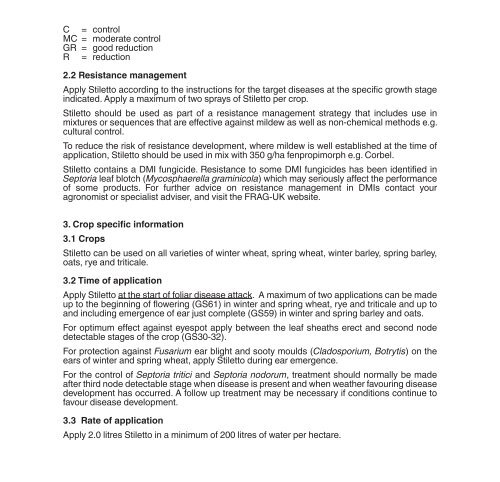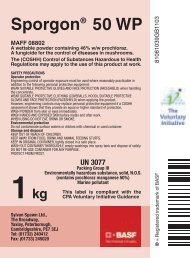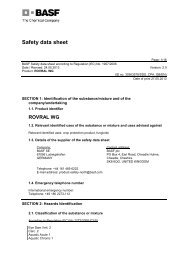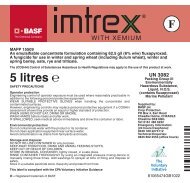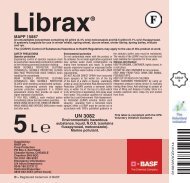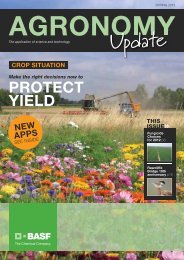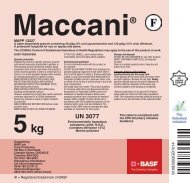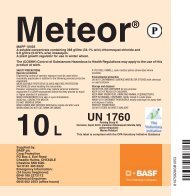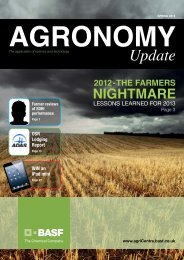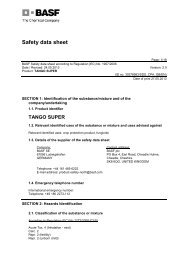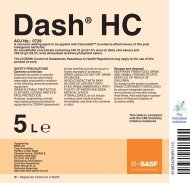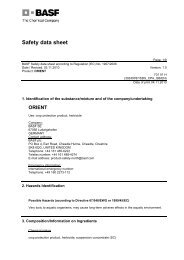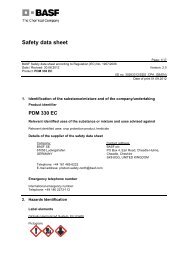C = controlMC = moderate controlGR = good reductionR = reduction2.2 Resistance managementApply Stiletto according to the instructions for the target diseases at the specific growth stageindicated. Apply a maximum of two sprays of Stiletto per crop.Stiletto should be used as part of a resistance management strategy that includes use inmixtures or sequences that are effective against mildew as well as non-chemical methods e.g.cultural control.To reduce the risk of resistance development, where mildew is well established at the time ofapplication, Stiletto should be used in mix with 350 g/ha fenpropimorph e.g. Corbel.Stiletto contains a DMI fungicide. Resistance to some DMI fungicides has been identified inSeptoria leaf blotch (Mycosphaerella graminicola) which may seriously affect the performanceof some products. For further advice on resistance management in DMIs contact youragronomist or specialist adviser, and visit the FRAG-<strong>UK</strong> website.3. Crop specific information3.1 CropsStiletto can be used on all varieties of winter wheat, spring wheat, winter barley, spring barley,oats, rye and triticale.3.2 Time of applicationApply Stiletto at the start of foliar disease attack. A maximum of two applications can be madeup to the beginning of flowering (GS61) in winter and spring wheat, rye and triticale and up toand including emergence of ear just complete (GS59) in winter and spring barley and oats.For optimum effect against eyespot apply between the leaf sheaths erect and second nodedetectable stages of the crop (GS30-32).For protection against Fusarium ear blight and sooty moulds (Cladosporium, Botrytis) on theears of winter and spring wheat, apply Stiletto during ear emergence.For the control of Septoria tritici and Septoria nodorum, treatment should normally be madeafter third node detectable stage when disease is present and when weather favouring diseasedevelopment has occurred. A follow up treatment may be necessary if conditions continue tofavour disease development.3.3 Rate of applicationApply 2.0 litres Stiletto in a minimum of 200 litres of water per hectare.~xmam1287498208.indd 4 19.10.2010 16:23:31
4. Following cropsAfter treating a cereal crop with Stiletto, cereals, oilseed rape, sugar beet, linseed, maize,clover, field beans, peas, turnips, carrots, cauliflower, onions, lettuce and potatoes can beplanted as succeeding crops.5. Mixing and Application5.1 MixingNever prepare more spray solution than is required.Fill the tank half full with water and start the agitation. To ensure thorough mixing of the product,invert the container several times before opening. Add the required quantity of Stiletto to thespray tank while re-circulating. Fill up the tank with water and continue agitation until sprayingis completed.When tank mixes are to be used, take due note of any instructions given as to the order ofmixing. Each product should be added separately to the spray tank and fully dispersed beforethe addition of any further product(s).On emptying the container, rinse container thoroughly by using an integrated pressure rinsingdevice or manually rinsing three times. Add washings to sprayer at time of filling and disposeof container safely.5.2 ApplicationApply as a MEDIUM spray, as defined by BCPC.The following does not form part of the product label under the Control of PesticidesRegulations 1986.With many products there is a general risk of resistance developing to the active ingredients.For this reason a change in activity cannot be ruled out. It is generally impossible to predict withcertainty how resistance may develop because there are so many crop- and use- connectedways of influencing this. We therefore have to exclude liability for damage or loss attributableto any such resistance that may develop. To help minimise any loss in activity the <strong>BASF</strong>recommended rate should in all events be adhered to.Numerous, particularly regional or regionally attributable, factors can influence the activity ofthe product. Examples include weather and soil conditions, crop plant varieties, crop rotation,treatment times, application amounts, admixture with other products, appearance of organismsresistant to active ingredients and spraying techniques. Under particular conditions a changein activity or damage to plants cannot be ruled out. The manufacturer or supplier is thereforeunable to accept any liability in such circumstances. All goods supplied by us are of high gradeand we believe them to be suitable, but as we cannot exercise control over their mixing or useor the weather conditions during and after application, which may affect the performance of thematerial, all conditions and warranties, statutory or otherwise, as to the quality or fitness for anypurpose of our goods are excluded and no responsibility will be accepted by us for any damageor injury whatsoever arising from their storage, handling, application or use; but nothing shouldbe deemed to exclude or restrict any liability upon us which cannot be excluded or restrictedunder the provisions of the Unfair Contract Terms Act 1977 or any similar applicable law.~xmam1287498208.indd 5 19.10.2010 16:23:31


